Abstract
Feline immunodeficiency virus (FIV), formerly called feline T-lymphotropic lentivirus, causes an immune deficiency in cats that is very similar to the acquired immune deficiency syndrome in humans (N. C. Pedersen, E. M. Ho, M. L. Brown, and J. K. Yamamoto, Science 235:790-793, 1987). We have examined the reverse transcriptase of this virus to determine whether it is similar enough to the reverse transcriptase of the human immunodeficiency virus type 1 (HIV-1) to enable its use as a model for chemotherapy for acquired immune deficiency syndrome. The FIV reverse transcriptase is similar to that of HIV-1 in sensitivity to the noncompetitive inhibitor phosphonoformate (Ki, 0.3 microM) and relative insensitivity to phosphonoacetate. This enzyme was also sensitive to two competitive inhibitors, the 5'-triphosphates of 2', 3'-dideoxythymidine (Ki, 3.4 nM) and 3'-azido-3'-deoxythymidine (AZT; Ki, 6.2 nM). The ratios of Ki/Km for these two competitive inhibitors are similar to the ratios calculated from previously reported data for the HIV-1 enzyme assayed under identical conditions. In contrast, the FIV enzyme is different from the reverse transcriptase of avian myeloblastosis virus in sensitivity to those inhibitors. The replication of FIV in Crandell feline kidney cells was inhibited by AZT; virus production was inhibited more than 95% by 1.0 microM AZT.
Full text
PDF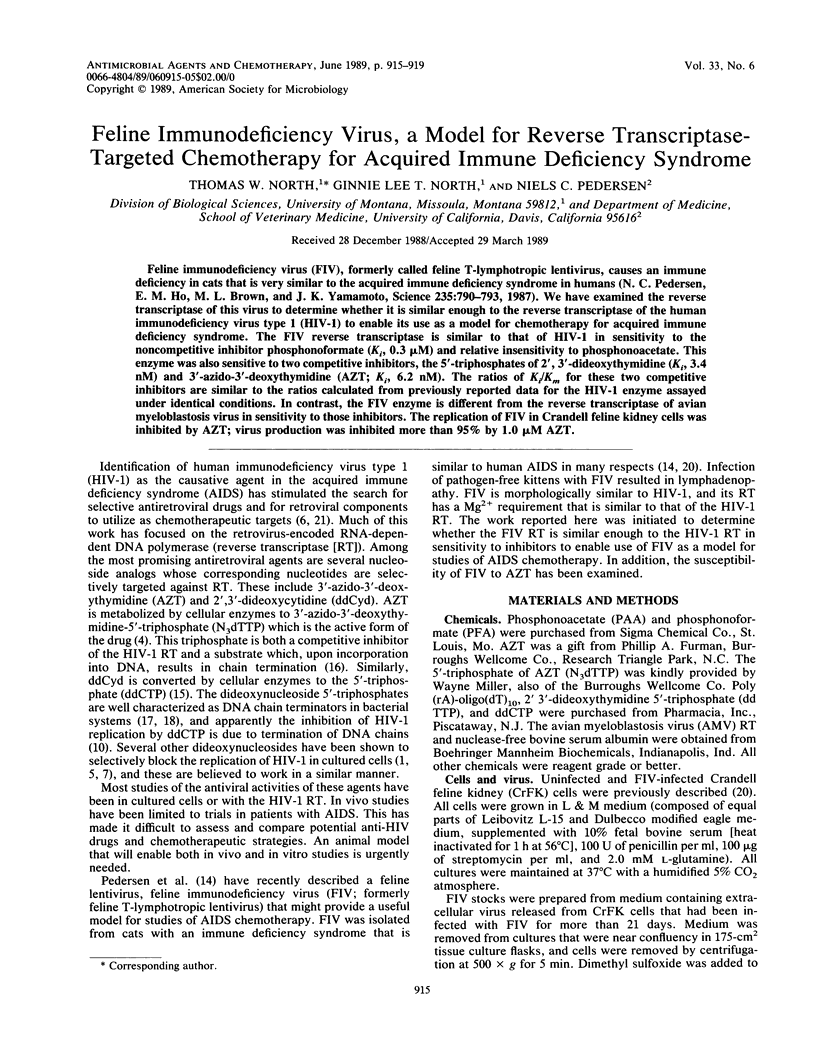
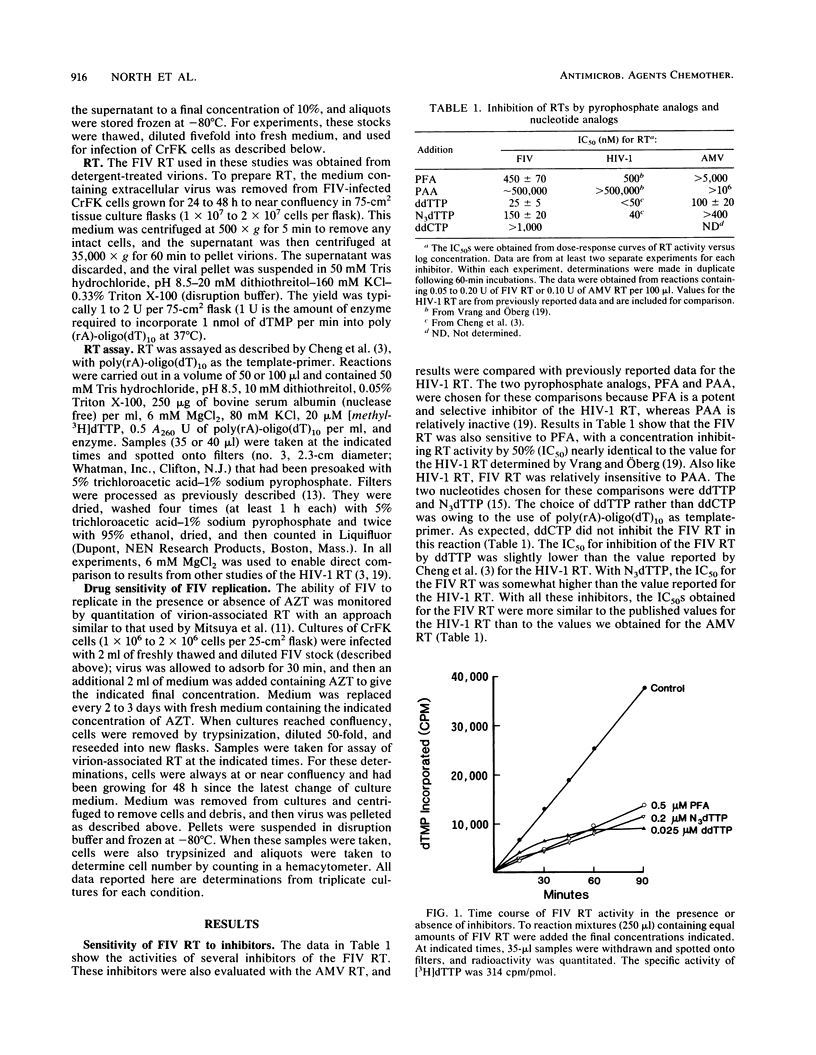
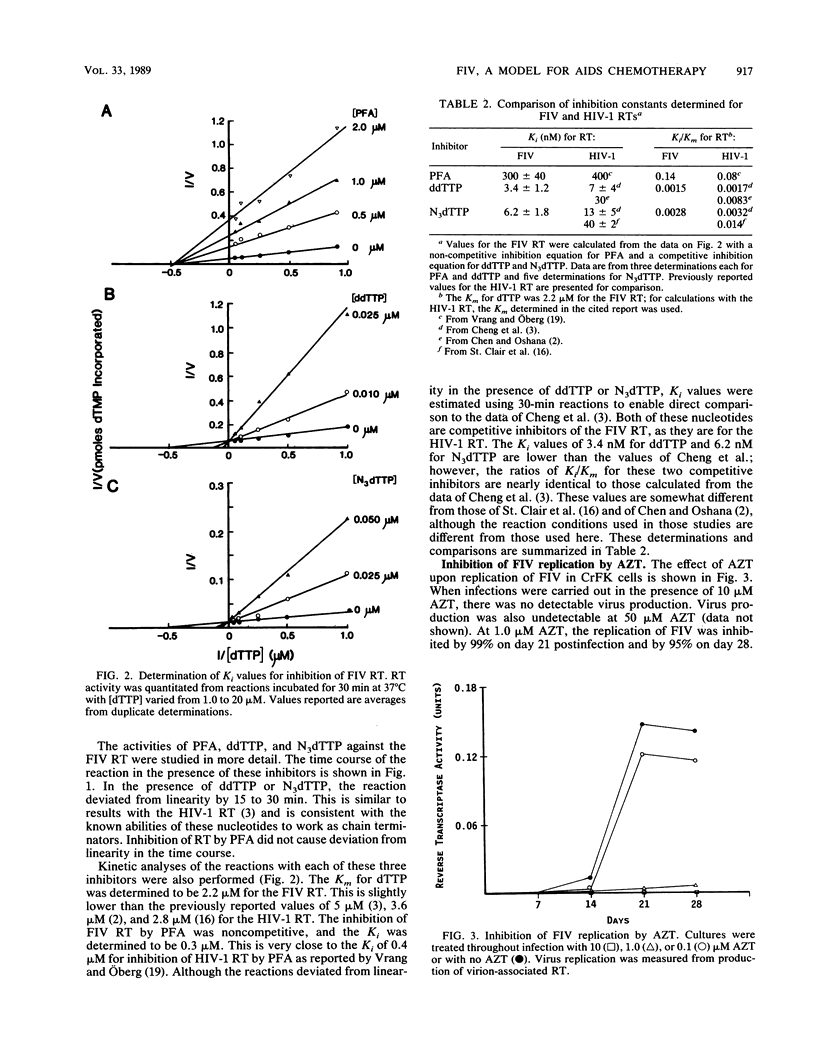
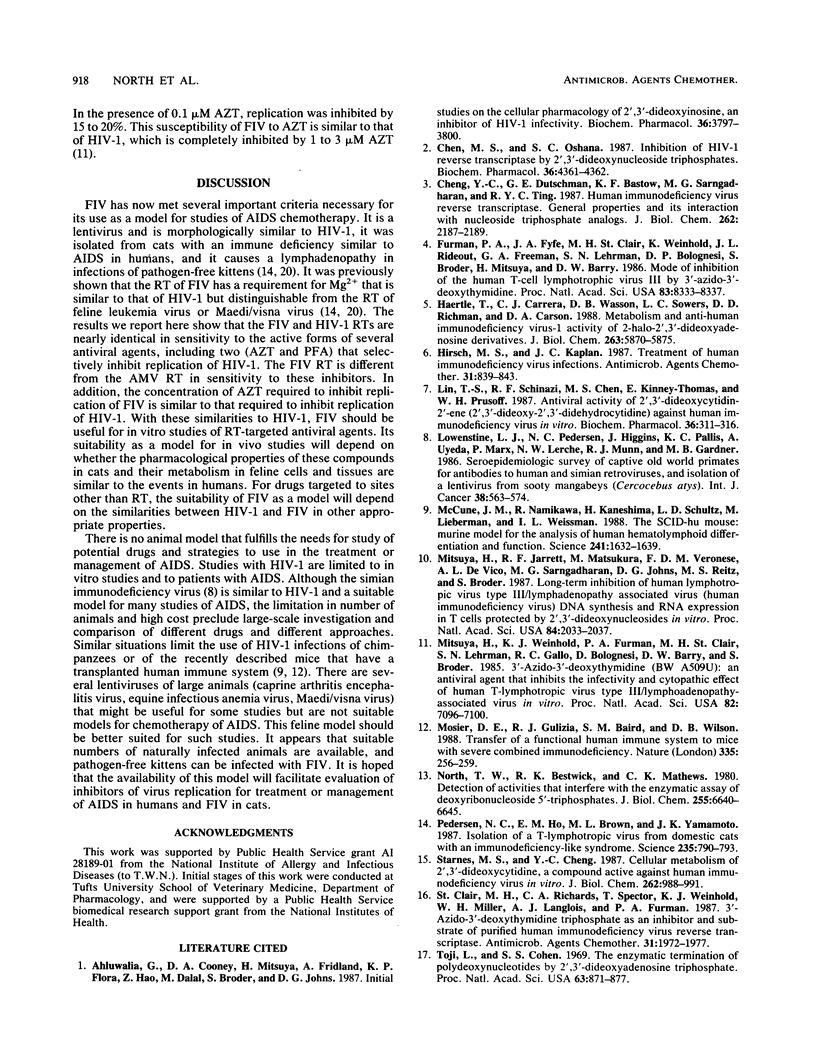
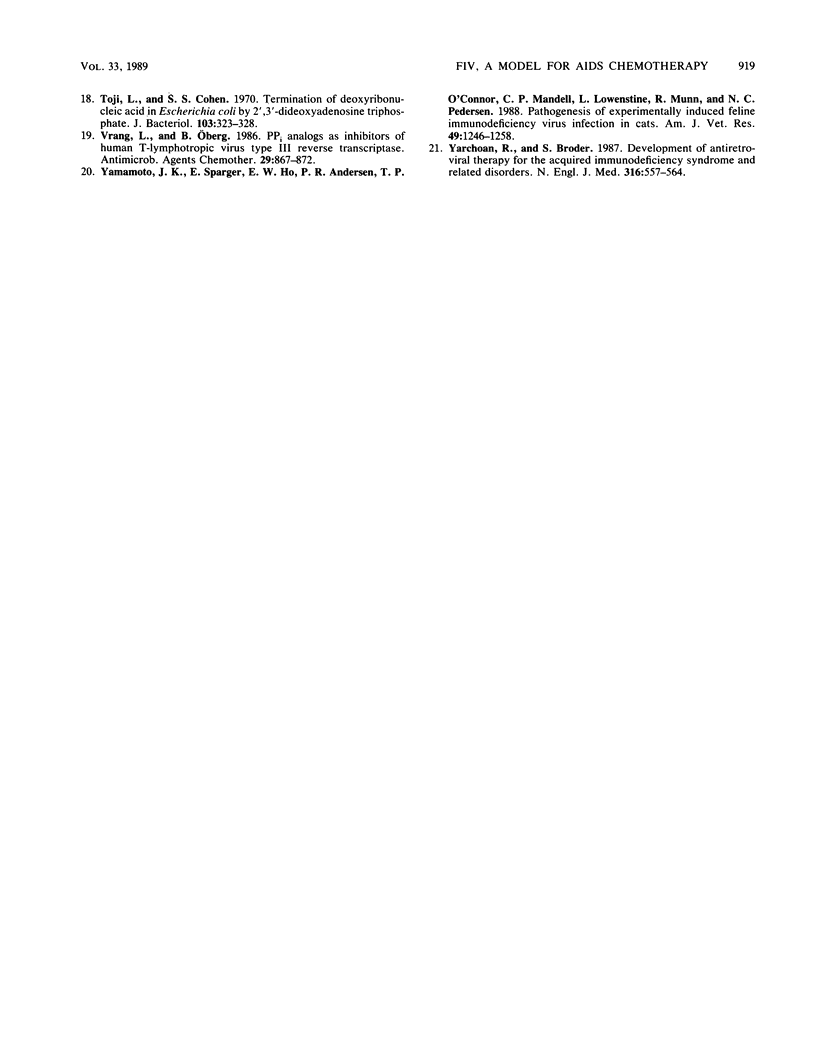
Selected References
These references are in PubMed. This may not be the complete list of references from this article.
- Ahluwalia G., Cooney D. A., Mitsuya H., Fridland A., Flora K. P., Hao Z., Dalal M., Broder S., Johns D. G. Initial studies on the cellular pharmacology of 2',3'-dideoxyinosine, an inhibitor of HIV infectivity. Biochem Pharmacol. 1987 Nov 15;36(22):3797–3800. doi: 10.1016/0006-2952(87)90440-0. [DOI] [PubMed] [Google Scholar]
- Chen M. S., Oshana S. C. Inhibition of HIV reverse transcriptase by 2',3'-dideoxynucleoside triphosphates. Biochem Pharmacol. 1987 Dec 15;36(24):4361–4362. doi: 10.1016/0006-2952(87)90685-x. [DOI] [PubMed] [Google Scholar]
- Cheng Y. C., Dutschman G. E., Bastow K. F., Sarngadharan M. G., Ting R. Y. Human immunodeficiency virus reverse transcriptase. General properties and its interactions with nucleoside triphosphate analogs. J Biol Chem. 1987 Feb 15;262(5):2187–2189. [PubMed] [Google Scholar]
- Furman P. A., Fyfe J. A., St Clair M. H., Weinhold K., Rideout J. L., Freeman G. A., Lehrman S. N., Bolognesi D. P., Broder S., Mitsuya H. Phosphorylation of 3'-azido-3'-deoxythymidine and selective interaction of the 5'-triphosphate with human immunodeficiency virus reverse transcriptase. Proc Natl Acad Sci U S A. 1986 Nov;83(21):8333–8337. doi: 10.1073/pnas.83.21.8333. [DOI] [PMC free article] [PubMed] [Google Scholar]
- Haertle T., Carrera C. J., Wasson D. B., Sowers L. C., Richman D. D., Carson D. A. Metabolism and anti-human immunodeficiency virus-1 activity of 2-halo-2',3'-dideoxyadenosine derivatives. J Biol Chem. 1988 Apr 25;263(12):5870–5875. [PubMed] [Google Scholar]
- Hirsch M. S., Kaplan J. C. Treatment of human immunodeficiency virus infections. Antimicrob Agents Chemother. 1987 Jun;31(6):839–843. doi: 10.1128/aac.31.6.839. [DOI] [PMC free article] [PubMed] [Google Scholar]
- Lin T. S., Schinazi R. F., Chen M. S., Kinney-Thomas E., Prusoff W. H. Antiviral activity of 2',3'-dideoxycytidin-2'-ene (2',3'-dideoxy-2',3'-didehydrocytidine) against human immunodeficiency virus in vitro. Biochem Pharmacol. 1987 Feb 1;36(3):311–316. doi: 10.1016/0006-2952(87)90287-5. [DOI] [PubMed] [Google Scholar]
- Lowenstine L. J., Pedersen N. C., Higgins J., Pallis K. C., Uyeda A., Marx P., Lerche N. W., Munn R. J., Gardner M. B. Seroepidemiologic survey of captive Old-World primates for antibodies to human and simian retroviruses, and isolation of a lentivirus from sooty mangabeys (Cercocebus atys). Int J Cancer. 1986 Oct 15;38(4):563–574. doi: 10.1002/ijc.2910380417. [DOI] [PubMed] [Google Scholar]
- McCune J. M., Namikawa R., Kaneshima H., Shultz L. D., Lieberman M., Weissman I. L. The SCID-hu mouse: murine model for the analysis of human hematolymphoid differentiation and function. Science. 1988 Sep 23;241(4873):1632–1639. doi: 10.1126/science.241.4873.1632. [DOI] [PubMed] [Google Scholar]
- Mitsuya H., Jarrett R. F., Matsukura M., Di Marzo Veronese F., DeVico A. L., Sarngadharan M. G., Johns D. G., Reitz M. S., Broder S. Long-term inhibition of human T-lymphotropic virus type III/lymphadenopathy-associated virus (human immunodeficiency virus) DNA synthesis and RNA expression in T cells protected by 2',3'-dideoxynucleosides in vitro. Proc Natl Acad Sci U S A. 1987 Apr;84(7):2033–2037. doi: 10.1073/pnas.84.7.2033. [DOI] [PMC free article] [PubMed] [Google Scholar]
- Mitsuya H., Weinhold K. J., Furman P. A., St Clair M. H., Lehrman S. N., Gallo R. C., Bolognesi D., Barry D. W., Broder S. 3'-Azido-3'-deoxythymidine (BW A509U): an antiviral agent that inhibits the infectivity and cytopathic effect of human T-lymphotropic virus type III/lymphadenopathy-associated virus in vitro. Proc Natl Acad Sci U S A. 1985 Oct;82(20):7096–7100. doi: 10.1073/pnas.82.20.7096. [DOI] [PMC free article] [PubMed] [Google Scholar]
- Mosier D. E., Gulizia R. J., Baird S. M., Wilson D. B. Transfer of a functional human immune system to mice with severe combined immunodeficiency. Nature. 1988 Sep 15;335(6187):256–259. doi: 10.1038/335256a0. [DOI] [PubMed] [Google Scholar]
- North T. W., Bestwick R. K., Mathews C. K. Detection of activities that interfere with the enzymatic assay of deoxyribonucleoside 5'-triphosphates. J Biol Chem. 1980 Jul 25;255(14):6640–6645. [PubMed] [Google Scholar]
- Pedersen N. C., Ho E. W., Brown M. L., Yamamoto J. K. Isolation of a T-lymphotropic virus from domestic cats with an immunodeficiency-like syndrome. Science. 1987 Feb 13;235(4790):790–793. doi: 10.1126/science.3643650. [DOI] [PubMed] [Google Scholar]
- St Clair M. H., Richards C. A., Spector T., Weinhold K. J., Miller W. H., Langlois A. J., Furman P. A. 3'-Azido-3'-deoxythymidine triphosphate as an inhibitor and substrate of purified human immunodeficiency virus reverse transcriptase. Antimicrob Agents Chemother. 1987 Dec;31(12):1972–1977. doi: 10.1128/aac.31.12.1972. [DOI] [PMC free article] [PubMed] [Google Scholar]
- Starnes M. C., Cheng Y. C. Cellular metabolism of 2',3'-dideoxycytidine, a compound active against human immunodeficiency virus in vitro. J Biol Chem. 1987 Jan 25;262(3):988–991. [PubMed] [Google Scholar]
- Toji L., Cohen S. S. Termination of deoxyribonucleic acid in Escherichia coli by 2',3'-dideoxyadenosine. J Bacteriol. 1970 Aug;103(2):323–328. doi: 10.1128/jb.103.2.323-328.1970. [DOI] [PMC free article] [PubMed] [Google Scholar]
- Toji L., Cohen S. S. The enzymatic termination of polydeoxynucleotides by 2',3'-dideoxyadenosine triphosphate. Proc Natl Acad Sci U S A. 1969 Jul;63(3):871–877. doi: 10.1073/pnas.63.3.871. [DOI] [PMC free article] [PubMed] [Google Scholar]
- Vrang L., Oberg B. PPi analogs as inhibitors of human T-lymphotropic virus type III reverse transcriptase. Antimicrob Agents Chemother. 1986 May;29(5):867–872. doi: 10.1128/aac.29.5.867. [DOI] [PMC free article] [PubMed] [Google Scholar]
- Yamamoto J. K., Sparger E., Ho E. W., Andersen P. R., O'Connor T. P., Mandell C. P., Lowenstine L., Munn R., Pedersen N. C. Pathogenesis of experimentally induced feline immunodeficiency virus infection in cats. Am J Vet Res. 1988 Aug;49(8):1246–1258. [PubMed] [Google Scholar]
- Yarchoan R., Broder S. Development of antiretroviral therapy for the acquired immunodeficiency syndrome and related disorders. A progress report. N Engl J Med. 1987 Feb 26;316(9):557–564. doi: 10.1056/NEJM198702263160925. [DOI] [PubMed] [Google Scholar]


